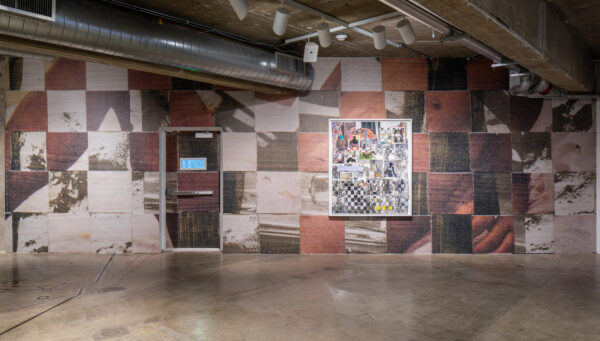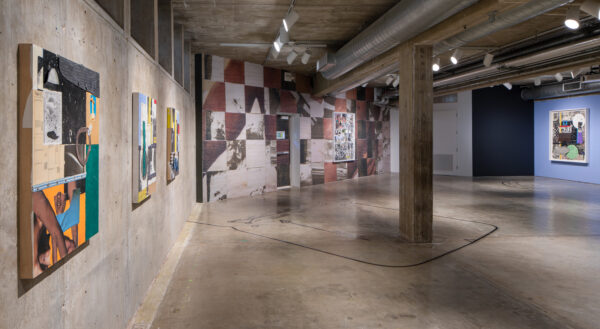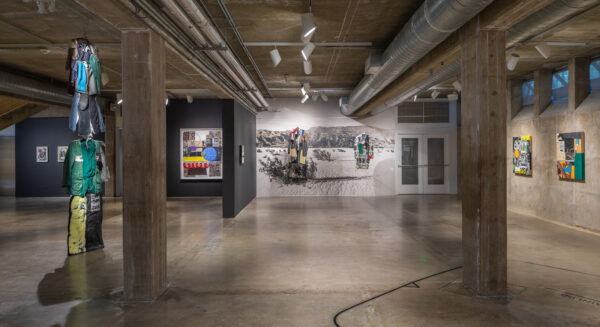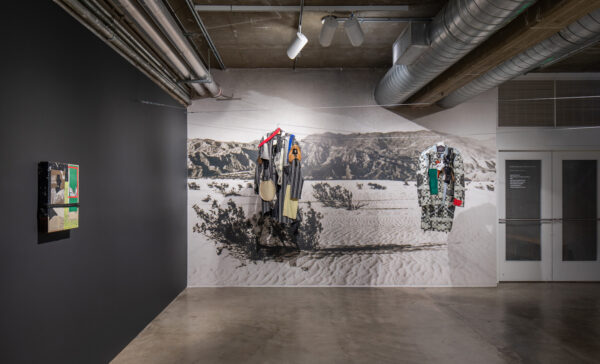Para leer este artículo en español, por favor vaya aquí. To read this article in Spanish, please go here.

Installation view of “Troy Montes Michie: Rock of Eye” at the Contemporary Arts Museum Houston, 2022. Photo by Sean Fleming.
What does it mean to be from a place perceived as liminal, prone to shifting in the public eye? A space where crossing a line is a way of life, and where life is not possible without both sides of that line? Troy Montes Michie’s powerful solo exhibition Rock of Eye, currently on view at Contemporary Arts Museum Houston (CAMH), explores these questions through collage, fashion, and installation. Drawing from the artist’s own experience growing up in the U.S./Mexico borderlands of El Paso, Texas, in Montes Michie’s care the border exceeds concepts, becoming both a challenge and a space of belonging. Rock of Eye is brought to CAMH as part of a collaboration between the Californian African American Museum in Los Angeles and the Rivers Institute for Contemporary Art & Thought in New Orleans.
The exhibition takes its name from a tailoring term. “Rock of eye” refers to a process of making clothes that relies on the eye — that is, feeling — more than measurements. The work focuses on the political implications of Zoot Suits, a mode of fashion worn by Black and brown youth in the 1930s and 40s as a form of protest against assimilation. Zoot Suits were famously banned for being unpatriotic and a waste of resources.

Installation view of “Troy Montes Michie: Rock of Eye” at the Contemporary Arts Museum Houston, 2022. Photo by Sean Fleming.
“Drapery is a kind of drawing in space,” the exhibition wall text reads, “a freehand, an intuition, a trust of materials.” Through his focus on the Zoot Suits and their racialized history, Montes Michie connects the border to collage and fashion. In terms of border politics, what does it mean to make an evaluative decision based on feeling over “hard fact?” In pieces such as America is Woven of Many Threads #1 (2019) and Foreground As Background (2018), both fabric and body are geographies. The collapsing of the topographies of the skin and the land reveals a spatial entitlement that undergirds the work, speaking of issues of citizenship and the “right” to belong. Rock of Eye brings these concepts to life, linking them to both lived experience and media culture through three-dimensional objects, the suits themselves, and stitched magazine collages.

Installation view of “Troy Montes Michie: Rock of Eye” at the Contemporary Arts Museum Houston, 2022. Photo by Sean Fleming.
This “rock of eye” trust of materials, intuition, and feeling implies the social weight of the circulation of style. Walter Benjamin saw fashion as a metaphor for time and history, seeing its power to literally mold a new look for history, reshape historical structures, and reframe the way we see past eras. The Meaning of Style author Dick Hebdige referred to youth fashion as “…a catalogue of beautifully broken codes.” Both collage and fashion are acts of circulation, reusing the same materials over and over again to see what they can do, punctuating their power and longevity.
Was the Beautiful Woman in the Mirror of the Water You or Me? (2022) focuses on the figure of the Pachuca, a femme wearer of the zoot suit. The 40-foot stream of magazine spreads, fabric patterns, and garment bags weaves together various images of women in suits, redefining and contemporizing the action of rebellion through dress. The piece’s virtuosity reveals Montes Michie’s early interest in José Clemente Orozco. As one walks with the piece, smaller narratives unfurl into one sprawling tableau of activity, like an ongoing sentence, an ode to plurality.

Installation view of “Troy Montes Michie: Rock of Eye” at Contemporary Arts Museum Houston, 2022. Photo by Sean Fleming.
Compositionally, Rock of Eye maintains an allegiance to the line, less as boundary than as threshold. In Out of Sight, Out of Mind (2018), an enlarged and then shrinking line pattern that both interrupts and links magazine images of Black and brown posers to each other and their backgrounds. For Open Book (2020), Montes Michie extends the implication of one body, using its negative to imply the erotic and the powerful in a number of settings — the bed, the active outdoors. In each module of the collage, patterns repeat and warp across materials, from thread to linen to ink.
Montes Michie’s multimedia use of the line — in fabric, composition, collage — is an ode to the elasticity of thresholds, the porosity of borders. It’s also a testament to the ways in which Black and brown folks have historically troubled popular culture’s understanding of borders through fashion. As Montes Michie notes in our recent conversation, “Collage comes up in moments of upheaval. It disrupts the language of mass culture with an alternative message.” The early Zoot Suiters used their dress as a way to push back against their criminalization. Through over-sized jackets, colorful high waisted slacks, and felt hats, they attested their worth and right to belong by refusing complacency, in favor of the high visibility of the zoot suit.
To aid the audience’s understanding of this political weight of fashion, the exhibition features a number of learning materials, including Catherine S. Ramírez’s Duke University Press volume The Woman in the Zoot Suit: Gender, Nationalism, and the Cultural Politics of Memory. This time period was important to the history of fashion, as haute couture dwindled in popularity and in fashion houses because of its penchant for excess, and was shut down in the face of war-time restrictions. Conversely, the Black and brown youth of the States embraced the everyday, adopting a rasquache aesthetic to counteract their racial profiling and pressure to assimilate, making use of everyday materials — things that other people consider kitsch — and transforming them into symbols of empowerment and resistance.

Installation view of “Troy Montes Michie: Rock of Eye” at the Contemporary Arts Museum Houston, 2022. Photo by Sean Fleming.
Rock of Eye includes an experimentation with a floor element and wall color. “I wanted the viewer to feel as if they were inside one of the collages,” Montes Michie explained via phone, “to use the line of the clothing pattern. It’s almost like a drawing to me. It’s instructional, it’s flat but it’s using something to make volume. I wanted to make a terrain for the viewer to walk through but also to cross, so they wouldn’t have to follow the path.”
In Rock of Eye, Montes Michie’s stitch is as generous as it is critical. It suggests and invites, suturing together pieces of history and contemporary life, popular culture, and modes of youth rebellion that remain overlooked and untold. As Rivers Institute Founding Director Andrea Andersson asserts, “In the art of Troy Montes Michie, styling is a form of resistance and an act of reconstruction. The stitch is a threshold to cross.”
Troy Montes Michie: Rock of Eye is on view at the Contemporary Art Museum Houston through January 29, 2023.


